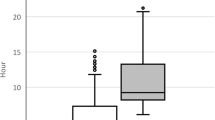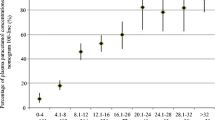Abstract
Background
Treatment of single-time-point ingestion acute paracetamol (acetaminophen) poisoning with N-acetylcysteine (NAC) is guided by plotting a timed plasma paracetamol concentration on established nomograms. Guidelines in the UK differ from those in the U.S. and Australasia by having two treatment lines on the nomogram. Patients deemed to be at ‘normal’ risk of hepatotoxicity are treated using the treatment line starting at 200 mg/L at 4 h post-ingestion; those at higher risk are treated using the ‘high risk’ treatment line starting at 100 mg/L at 4 h post-ingestion.
Aim
To examine the effect on treatment numbers if UK guidelines were to adopt a single treatment line nomogram or lower, risk-stratified treatment lines.
Methods
We undertook a retrospective analysis of a series of acute single-time-point paracetamol poisonings presenting to our inner city emergency department. Treatment numbers and effect on treatment costs were modelled for three alternative scenarios: a 150 line—a combined single treatment line starting at a 4 h concentration of 150 mg/L, a 100 line—a combined single treatment line starting at a 4 h concentration of 100 mg/L, and a 150/75 line—a double treatment line at the lower concentrations of 150 mg/L for normal risk and 75 mg/L for high risk patients.
Results
A total of 1,214 cases were identified. Under current UK guidance, 133 (11.0%) high risk cases and 98 (8.1%) normal risk cases needed treatment (total 231, 19.0%). A 150 line would result in 87 (7.2%) high risk cases and 155 (12.8%) normal risk cases needing treatment (total 242, 19.9%). A 100 line would result in 133 (11.0%) high risk and 251 (20.7%) normal risk cases needing treatment (total 384, 31.6%). A 150/75 line would result in 153 (12.6%) high risk and 155 (12.8%) normal risk cases needing treatment (total 308, 25.4%).
Conclusions
Both a 100 line and a 150/75 line would result in a large increase in the number of patients being treated and an associated increase in the costs of treatment. A single 150 mg/L treatment line would simplify treatment algorithms and lead to a similar number of patients being treated with NAC overall. A potential concern however is whether any of the high risk cases that would no longer be treated might develop significant hepatotoxicity. After consideration of the evidence for dual treatment lines, we feel that these risks are small and that it is worth reconsidering a change of treatment recommendations to a single 150 line.
Similar content being viewed by others
References
National Poisons Information Service (2011) Annual report 2010/2011 http://www.npis.org/NPISAnnualReport2010-11.pdf. Accessed 21 February 2012
Prescott LF, Illingworth RN, Critchley JA, Stewart MJ, Adam RD, Proudfoot AT (1979) Intravenous N-acetylcysteine: the treatment of choice for paracetamol poisoning. BMJ 2:1097–1100
Wolf SJ, Heard K, Sloan EP, Jagoda AS (2007) Clinical policy: critical issues in the management of patients presenting to the emergency department with acetaminophen overdose. Ann Emerg Med 50:292–313
Daly FF, Fountain JS, Murray L, Graudins A, Buckley NA (2008) Guidelines for the management of paracetamol poisoning in Australia and New Zealand—explanation and elaboration. A consensus statement from clinical toxicologists consulting to the Australasian poisons information centres. Med J Aust 188:296–301
NPIS (2012) TOXBASE: the primary clinical toxicological database of the National Poisons Information Service. http://www.toxbase.org/Poisons-Index-A-Z/P-Products/Paracetamol. Accessed 21 February 2012
Ferner RE, Dear JW, Bateman DN (2011) Management of paracetamol poisoning. BMJ 342:d2218
Wallace CI, Dargan PI, Jones AL (2002) Paracetamol overdose: an evidence based flowchart to guide management. Emerg Med J 19:202–205
Kalsi SS, Dargan PI, Waring WS, Wood DM (2011) A review of the evidence for a reduction in hepatic glutathione increasing the risk of liver toxicity after paracetamol overdose. Open Access Emerg Med 3:87–96. doi:10.2147/OAEM.S24963
Rowden AK, Norvell J, Eldridge DL, Kirk MA (2005) Updates on acetaminophen toxicity. Med Clin N Am 89:1145–1159
Rumack BH (2002) Acetaminophen hepatotoxicity: the first 35 years. J Toxicol Clin Toxicol 40:3–20
Waring SW, Alexandra SF, Robinson OD, Dow MA, Pettie JM (2008) Lower incidence of anaphylactoid reactions to N-acetylcysteine in patients with high acetaminophen concentrations after overdose. Clin Toxicol 46:490–500
NHS (2012) Hospital episode statistics. http://www.hesonline.nhs.uk. Accessed 21 February 2012
Department of Health (2012) Publications and statistics. http://www.dh.gov.uk/en/Publicationsandstatistics. Accessed 21 February 2012
Yarema MC, Johnson DW, Berlin RJ, Sivilotti ML, Nettel-Aguirre A et al (2009) Comparison of the 20-hour intravenous and 72-hour oral acetylcysteine protocols for the treatment of acute acetaminophen poisoning. Ann Emerg Med 54:606–614
Vale JA, Meredith TJ, Goulding R (1981) Treatment of acetaminophen poisoning: the use of oral methionine. Arch Intern Med 141:394–396
Smilkstein MJ, Knapp GL, Kulig KW, Rumack BH (1988) Efficacy of oral acetylcysteine in the treatment of acetaminophen overdose. N Engl J Med 319:1557–1562
Smilkstein MJ, Bronstein AC, Linden C, Augentein WL, Kulig KW, Rumack BH (1991) Acetaminophen overdose: a 48 hour intravenous N-acetylcysteine treatment protocol. Ann Emerg Med 20:1058–1063
Beer C, Pakravan N, Hudson M, Smith LT, Simpson K, Bateman DN et al (2007) Liver unit admission following paracetamol overdose with concentrations below current UK treatment thresholds. QJM 100:93–96
Pakravan N, Waring SW, Sharma S, Ludlam C, Megson I, Bateman N (2008) Risk factors and mechanisms of anaphylactoid reactions to acetylcysteine in acetaminophen overdose. Clin Toxicol 46:697–702
Zyou SH, Awang R, Sulaiman SAS, Khan HRM, Sawalha AF et al (2010) Relationship between serum acetaminophen concentration and N-acetylcysteine-induced adverse drug reactions. Basic Clin Pharmacol Toxicol 107:718–723
Mant T, Tempowski J, Volans G, Talbot J (1984) Adverse reactions to acetylcysteine and effects of overdose. BMJ 289:217–219
Appelboam AV, Dargan PI, Knighton J (2002) Fatal anaphylactoid reaction to N-acetylcysteine: caution in patients with asthma. Emerg Med J 19:594–595
Reid D, Hazell W (2003) Paracetamol poisoning: which nomogram should we use? Emerg Med (Fremantle) 15:486–496
Pettie JM, Dow MA, Sandilands EA, Thanacoody RHK, Bateman ND (2011) An integrated care pathway improves the management of paracetamol poisoning. Emerg Med J. doi:10.1136/emj.2011.111922
McQuade DJ, Aknuri S, Dargan PI, Wood DM (2012) Management of acute paracetamol (acetaminophen) toxicity: a standardised proforma improves risk assessment and overall risk stratification by emergency medicine doctors. Emerg Med J. doi:10.1136/emermed -2011-200889
Sarbjeet SK, Wood DM, Waring SW, Dargan PI (2011) Does cytochrome P450 liver isoenzyme induction increase the risk of liver toxicity after paracetamol overdose? Open Access Emerg Med 3:69–76
Buckley NA, Srinivasan J (2002) Should a lower treatment line be used when treating paracetamol poisoning in patients with chronic alcoholism? A case for. Drug Saf 25:619–624
Dargan PI, Jones AL (2002) Should a lower treatment line be used when treating paracetamol poisoning in patients with chronic alcoholism? A case against. Drug Saf 25:625–632
Bridger S, Henderson K, Glucksman E, Ellis AJ, Henry JA, Williams R (1998) Lesson of the week: deaths from low dose paracetamol poisoning. BMJ 316:1724–1725
Routledge P, Vale JA, Bateman DN, Johnston GD, Jones A, Judd A et al (1998) Paracetamol (acetaminophen) poisoning. BMJ 317:1609–1610
Barnes J, Abban M, Howarth P (1998) Executive action needed to change national guideline [letter]. BMJ 317:1054
Cameron MG (1998) Lower threshold has not yet overburdened hospital services in Gloucester [letter]. BMJ 317:1055
Waring WS, Stephen AF, Robinson OD, Dow MA, Pettie JM (2008) Lower incidence of anaphylactoid reactions to N-acetylcysteine in patients with high acetaminophen concentrations after overdose. Clin Toxicol (Phila) 46:496–500
Conflict of interest
D.W. and P.D. have received a research grant from McNeill Pharmaceuticals for research into the home storage of paracetamol in the UK. P.D. has acted as an expert adviser to the U.S. Food and Drug Administration on paracetamol poisoning. J.K. is an advisor as part of the College of Emergency Medicine Clinical Effectiveness Committee to a panel at the UK Medicines and Healthcare Regulatory Authority on an ongoing review of paracetamol management.
Author information
Authors and Affiliations
Corresponding author
Rights and permissions
About this article
Cite this article
McQuade, D.J., Dargan, P.I., Keep, J. et al. Paracetamol toxicity: what would be the implications of a change in UK treatment guidelines?. Eur J Clin Pharmacol 68, 1541–1547 (2012). https://doi.org/10.1007/s00228-012-1285-7
Received:
Accepted:
Published:
Issue Date:
DOI: https://doi.org/10.1007/s00228-012-1285-7




